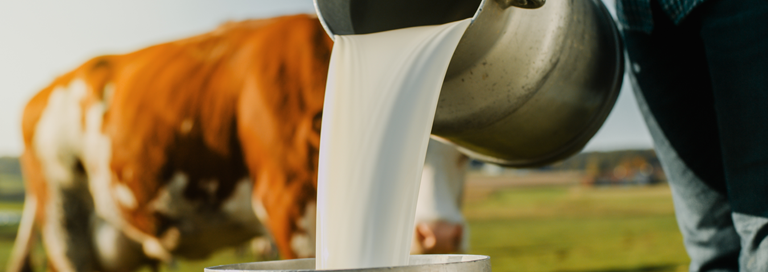It used to be that the most difficult choice you made regarding milk was whether it was delivered fresh to your house or you bought it at your local shop.
Today when you walk down the dairy aisle of the grocery store, the number of products that are called milk is mind-boggling.
These milk substitutes include soy, oat, almond, rice, potato, flax, and almost a dozen more.
I think it’s a fraud even to call this stuff milk.
Of course, the food industry wants you to think their alternatives are healthier for you than what comes from a cow…
Sadly, their advertising is working. Most Americans believe plant-based “milk products” are more nutritious than cow’s milk. It’s not true.
You don’t get the same protein, fat, calcium, or vitamin D that comes from fresh milk from grass-fed cows.
What you do get is a beverage filled with water, sweeteners, thickening agents, and additives.
But at least these milk alternatives are primarily made from natural ingredients. The next generation of animal-free milks are created entirely in a lab. They’re made using engineered yeast combined with DNA to produce the same proteins found in cow’s milk.1
It’s the latest example of the fake franken-foods being pushed on an unsuspecting public.
I come from a family of farmers, and milk was a staple of my diet growing up.
We’d have it delivered to the house in glass bottles. When I’d go to my grandmother’s, she’d pour me a glass straight from the bucket…straight from the cow.
Back then, we never worried about whether milk was raw or pasteurized. I know we were healthy, strong, and never sick a day.
You won’t find raw dairy products in your local grocery store today. It’s even against the law in some states. The CDC and FDA
want to scare you into thinking that unpasteurized milk poses “severe health risks and even death.”2Milk sourced from Big Agra’s factory farms is indeed dangerous to consume raw.
These cattle factories house hundreds, even thousands, of animals in a small, confined space. These unsanitary conditions are filled with waste, urine, chemicals like ammonia and methane, and disease-causing bacteria.
For decades, I’ve warned my patients and readers to stop eating anything from these industrial farms.
Nothing from these factory farms is safe.
On the other hand, numerous scientific studies have shown that raw milk from small family farms is safe and healthy.3
Grass-fed raw milk is a good source of important disease fighters like protein, bioavailable vitamins, minerals, and essential fatty acids, including DHA, amino acids, and probiotics, to strengthen your immune system. When you pasteurize milk, the heat destroys all of the immune-fighting properties. Pasteurization kills or severely damages these nutrients.
Extensive studies have shown that drinking raw milk is associated with lower rates of asthma, allergies, eczema, ear infections, and respiratory infections.
And grass-fed raw milk contains the most important health-building ingredient of all: enzymes. Enzymes are inflammation fighters and immune builders. But they’re destroyed within minutes during pasteurization.
Here is a sample of what’s lost:
- Amylase. Amylase breaks down carbohydrates in food as it’s digested.
- Catalase. Catalase is a strong antioxidant that protects cells.
- Lactase. This is what’s missing when people are lactose intolerant. Lactase makes it easier to absorb other nutrients as well.
- Lipase. Lipase breaks down fats like triglycerides and improves the way your body uses them.
- Phosphatase. Phosphatase helps your body absorb and use the calcium and phosphorous in milk.
- Lactoferrin. Lactoferrin helps protect you from disease. In fact, lactoferrin defends the body against invasion by bacteria, viruses, fungi, and parasites. Lactoferrin has the same protection-fighting power as a mother’s breast milk for an infant.
How to get raw milk no matter where you live
Because of the FDA’s overreach, raw milk can’t be transported over state lines. You can only buy it within the state that produces it. And that means it’s impossible to buy from a grocery store. But you can still find farm-fresh raw milk no matter where you live.
-
- Check out a farm near you. As interest in organic foods continues to grow, the number of small farms has increased.
- Order it online. If you can’t get to a farm, you can order online.
- Own a herd share. You can also purchase a share in a cow or on a farm in your area. You pay a monthly fee for board and milking; in return, you receive milk from “your cow.”
- If all else fails, look for a milk brand that is pasteurized through a low-heat process. Many health and natural food stores carry brands that use lower temperatures that don’t destroy enzymes and nutrients.
To Your Good Health,

Al Sears, MD, CNS
References:
1. https://www.foodnavigator-usa.com/Article/2022/02/24/betterland-foods-unveils-cow-free-milk-with-Perfect-Day-so-how-close-is-it-to-the-real-thing. Accessed on April 29,2022.
2. U.S. Food and Drug Administration. “The Dangers of Raw Milk.” https://www.fda.gov/media/119383/download. Accessed on April 29,2022.
3. Whitehead J and lake B.“Recent trends in unpasteurized fluid milk outbreaks, legalization, and consumption in the United States.” PLoS Curr. 2018 September 13;10.
4. Ochoa TJ, Cleary TG. “Effect of lactoferrin on enteric pathogens.” Biochimie. 2009 Jan; 91(1):30-4.

